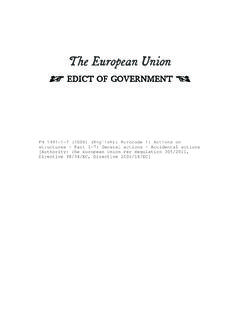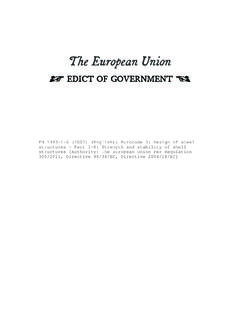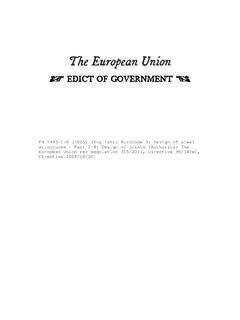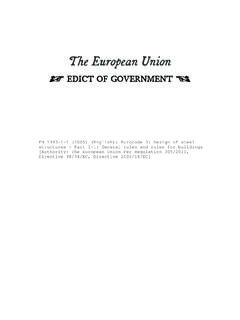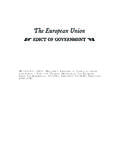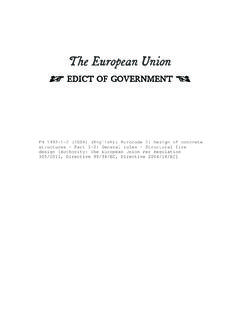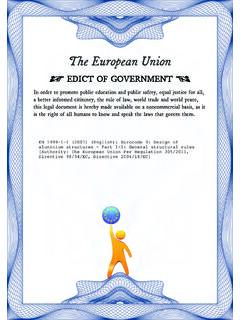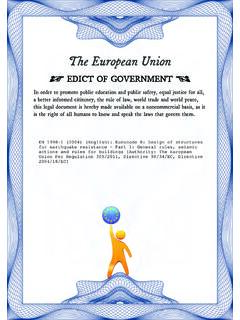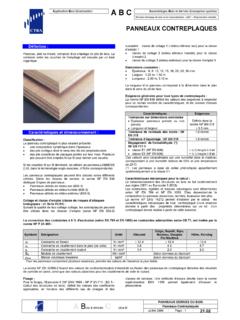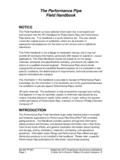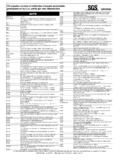Transcription of EN 1993-1-5: Eurocode 3: Design of steel …
1 The European UnionIn order to promote public education and public safety, equal justice for all, a better informed citizenry, the rule of law, world trade and world peace, this legal document is hereby made available on a noncommercial basis, as it is the right of all humans to know and speak the laws that govern them. EDICT OF GOVERNMENT EN 1993-1-5 (2006) (English): Eurocode 3: Design of steelstructures - Part 1-5: General rules - Plated structuralelements [Authority: The European Union Per Regulation305/2011, Directive 98/34/EC, Directive 2004/18/EC]EUROPEAN STANDARD NORME EUROPEENNE EUROpAISCHE NORM EN 1993-1-5 October 2006 ICS ; Supersedes ENV 1993-1-5: 1997 Incorporating corrigendum April 2009 English Version Eurocode 3 - Design of steel structures -Part 1-5: Plated structural elements Eurocode 3 -Calcul des structures en acier Partie 1-5: Plaques planes Eurocode 3 Bemessung und konstruktion von Stahlbauten Teil 1-5: Plattenbeulen This European Standard was approved by CEN on 13 January 2006.
2 CEN members are bound to comply with the CEN/CENELEC Internal Regulations which stipulate the conditions for giving this European Standard the status of a national standard without any alteration. Up-to-date lists and bibliographical references concerning such national standards may be obtained on application to the Central Secretariat or to any CEN member. This European Standard exists in three official versions (English, French, German). A version in any other language made by translation under the responsibility of a CEN member into its own language and notified to the Central Secretariat has the same status as the official versions. CEN members are the national standards bodies of Austria, Belgium, Cyprus, Czech Republic, Denmark, Estonia, Finland, France, Germany, Greece, Hungary, Iceland, Ireland, Italy, Latvia, Lithuania, Luxembourg, Malta, Netherlands, Norway, Poland, Portugal, Romania, Slovakia, Slovenia, Spain, Sweden, Switzerland and United Kingdom.
3 EUROPEAN COMMITTEE FOR STANDARDIZATION COMITE EUROPEEN DE NORMALISATION EUROP,. KOMlTEE FOR NORMUNG Management Centre: rue de Stassart, 36 B-1050 Brussels 2006 CEN All rights of exploitation in any form and by any means reserved worldwide for CEN national Members. Ref. No. EN 1993-1-5: 2006: E BS EN 1993-1-5: 2006 EN 1993-1-5: 2006 (E) Content 1 Introduction Scope N ormati ve references Terms and definitions Symbols 2 Basis of Design and nlodelling General Effective width models for global analysis Plate buckling effects on uniform members Reduced stress method Non uniform members Members with corrugated webs 3 Shear lag in 1l1ember Design General Effective~ width for elastic shear Shear lag at the ultimate limit state 4 Plate buckling effects due to direct stresses at the ultimate limit state General Resistance to direct stresses Effective cross section Plate elements without longitudinal stiffeners Stiffened plate elements with longitudinal stiffeners Verification 5 Resistance to shear Basis Design resistance Contribution from the web Contribution from flanges Verification 6 Resistance to transverse forces 6.
4 J Basis Design resistance Length of stiff bearing Reduction factor XF for effecti ve length for resistance Effective loaded length Verification 7 Interaction Interaction between shear force, bending moment and axial force Interaction between transverse force, bending moment and axial force 8 Flange induced buckling 9 Stiffeners and detailing General Direct stresses Shear Transverse loads 10 Reduced stress nlethod Annex A (informative) Calculation of critical stresses for stiffened plates 2 Page S 5 5 5 6 7 7 7 7 8 8 8 9 9 9 12 13 13 13 l3 IS 18 21 21 21 22 22 25 25 2S 25 26 26 27 27 28 28 28 29 29 30 30 30 34 35 36 38 Annex B (informative) Non uniform members Annex C (informative) Finite Elenlent Methods of Analysis (FEM) Annex D (informative) Plate girders with corrugated webs BS EN 1993-1-5: 2006 EN 1993-1-5: 2006 (E) 43 45 50 Annex E (normative) Alternative nlethods for deternlining effective cross sections 53 3 BS EN 1993-1-5: 2006 EN 1993-1-5: 2006 (E) Foreword This European Standard EN 1993-1-5" Eurocode 3: Design of steel structures Part : Plated structural elements, has been prepared by Technical Committee CENITC250 Structural Eurocodes , the Secretariat of which is held by BSI.
5 CEN/TC250 is responsible for all Structural Eurocodes. This European Standard shall be given the status of a National Standard, either by publication of an identical text or by endorsement, at the latest by April 2007 and conflicting National Standards shall be withdrawn at latest by March 20 1 O. This Eurocode supersedes ENV 1993-1-5. According to the CEN-CENELEC Internal Regulations, the National Standard Organizations of the fol1owing countries are bound to implement this European Standard: Austria, Belgium, Cyprus, Czech Republic, Denmark, Estonia, Finland, France, Germany, Greece, Hungary, Iceland, Ireland, Italy, Latvia, Lithuania, Luxembourg, Malta, Netherlands, Norway, Poland, Portugal, Romania, Slovakia, Slovenia, Spain, Sweden, Switzerland and United Kingdom. National annex for EN 1993-1-5 This standard gives alternative procedures, values and recommendations with notes indicating where national choices may have to be made.
6 The National Standard implementing EN 1993-1-5 should have a National Annex containing all Nationally Determined Parameters to be used for the Design of steel structures to be constructed in the relevant country. National choice is allowed in EN 1993-1-5 through: 4 (5) ( 1) (6) (2) (2) 8(2) (I) 1(9) 10(1 ) 10(5) ( 1) (2) (1) (3) (2) BS EN 1993-1-5: 2006 EN 1993-1-5: 2006 (E) 1 Introduction Scope (1) EN 1993-1-5 gives Design requirements of stiffened and unstiffened plates which are subject to in-plane forces. (2) Effects due to shear lag, in-plane load introduction and plate buckling for I-section girders and box girders are covered. Also covered are plated structural components subject to in-plane loads as in tanks and silos. The effects of out-of-plane loading are outside the scope of this document. NOTE 1: The rules in this part complement the rules for class I, 2, 3 and 4 sections, see EN 1993-1 I.
7 NOTE 2: For the Design of slender plates \vhich are subject to repeated direct stress and/or shear and also fatigue due to out-of-plane bending of plate elements (breathing) see EN 1993-2 and EN 1993-6. NOTE 3: For the effects of out-of-plane loading and for the combination of in-plane effects and out-or-plane loading effects see EN 1993-2 and EN 1993-1-7. NOTE 4: Single plate elements may be considered as /lat where the curvalUre radius r satisfies: a r?:. t where a is the panel width is the plate thickness Normative references ( ) (1) This European Standard incorporates, by dated or undated reference, provIsIons from other publications. These normative references are cited at the appropriate places in the text and the publications are listed hereafter. For dated references, subsequent amendments to or revisions of any of these publications apply to this European Standard only when incorporated in it by amendment or revision.
8 For undated references the latest edition of the publication referred to applies. EN 1993-1 1 Eurocode 3 : Design structures: Part 1-1: General rules and rilles for buildings Terms and definitions For the purpose of this standard, the following terms and definitions apply: elastic critical stress stress in a component at which the component becomes unstable when using small deflection elastic theory of a perfect structure membrane stress stress at mid-plane of the plate gross cross-section the total cross-sectional area of a member but excluding discontinuous longitudinal stiffeners effectiYe cross-section and effective width the gross cross-section or width reduced for the effects of plate buckling or shear between their effects the word "effective" is clarified as follows: "effectiveP" denotes effects of plate buckling or both; to distinguish 5 BS EN 1993-1-5: 2006 EN 1993-1-5: 2006 (E) "effective'" denotes effects of shear lag "effective" denotes effects of plate buckling and shear lag plated structure a structure built up from nominally flat plates which are connected together~ the plates may be stiffened or unstiffened stiffener a plate or section attached to a plate to resist buckling or to strengthen the plate; a stiffener is denoted: longitudinal if its direction is parallel to the member; transverse if its direction is perpendicular to the member.
9 Stiffened plate plate with transverse or longitudinal stiffeners or both subpanel unstiffened plate pOliion surrounded by flanges and/or stiffeners hybrid girder girder with flanges and web made of different steel grades; this standard assumes higher steel grade in flanges compared to webs sign convention unless otherwise stated compression is taken as positive Symbols (I) In addition to those given in EN 1990 and EN 1993-1-1, the following symbols are used: A,f total area of all the longitudinal stiffeners of a stiffened plate; As! gross cross sectional area of one transverse stiffener; Aeff effective cross sectional area; effectiveP cross sectional area; effectiveP cross sectional area for local buckling; a length of a stiffened or unstiffened plate; b width of a stiffened or unstiffened plate; bw ~clear width between welds for welded sections or between ends of radii for rolled sections; @il berr effective' width for elastic shear lag; Fr~d Design transverse force; hw c lear web depth between flanges; Len effective length for resistance to transverse forces, see 6; A1u<d Design plastic moment of resistance of a cross-section consisting of the flanges only; Design plastic moment of resistance of the cross-section (irrespective of cross-section class); MEd Design bending moment; NEd Design axial force~ thickness of the plate; 6 VEd Design shear force including shear from torque.
10 Wen effective elastic section modulus: fJ effectiveS width factor for elastic shear lag; (2) Additional symbols are defined where they first occur. 2 Basis of Design and modelling General BS EN 1993-1-5: 2006 EN 1993-1-5: 2006 (E) (J)P The effects of shear lag and plate buckling shall be taken into account at the ultimate, serviceability or fatigue limit states. NOTE: Partial factors /1.;10 and }<.,11 used in this part are defined for different applications in the National Annexes of EN 1993-1 to EN 1993-6. Effective width models for global analysis (])P The effects of shear lag and of plate buckling on the stiffness of members and joints shall be taken into account in the global analysis. (2) The effects of shear lag of flanges in global analysis may be taken into accollnt by the use of an effectiveS width. For simplicity this effectiveS width may be assumed to be uniform over the length of the span.
